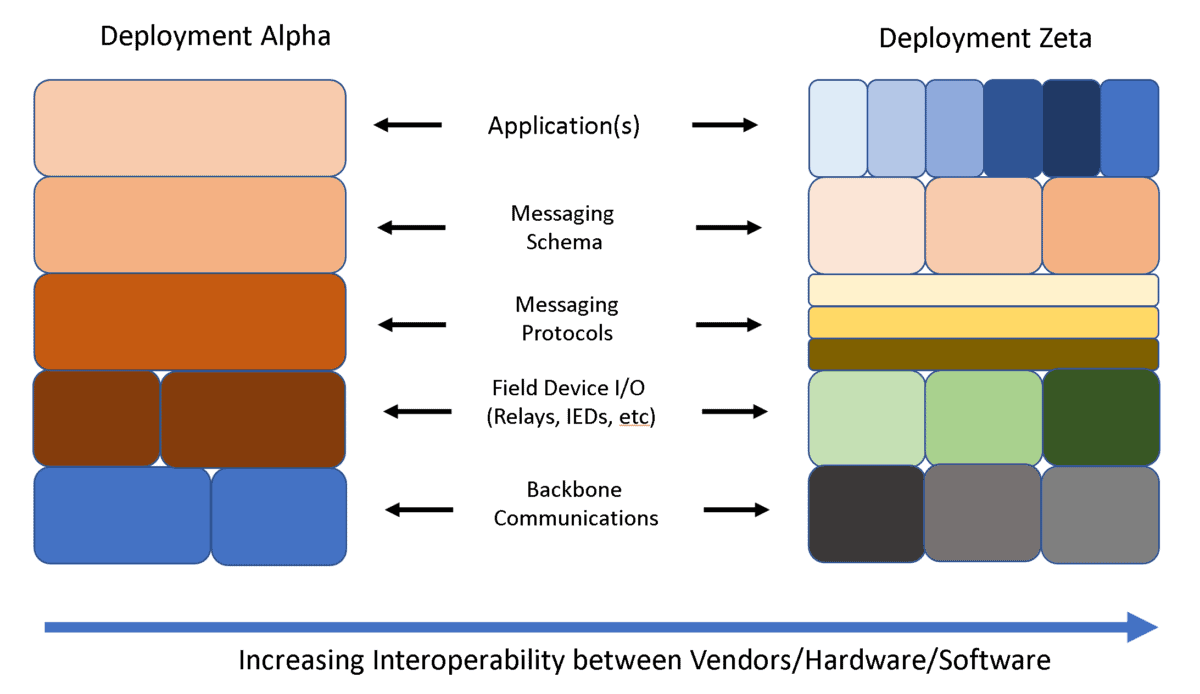
John Camilleri
Innovations in power generation, storage, and transmission technologies are forcing a shift away from centralized power generation towards a distributed, decentralized model. Utility operations are presented with new challenges related to security and controls; how they respond will shape the future of the decentralized energy landscape. This 3-part series will investigate the potential applications of distributed systems, as well as the role of interoperability in actualizing the decentralized energy revolution.
In the first and second installments of this series, I introduced the concept of the grid edge, the advantages and challenges presented by distributed systems, and some of the real-world applications of a distributed system approach. In this third and final post, I’ve focused on the critical nature of interoperability in a modern, decentralized grid.
Interoperability will bring us closer to the grid edge
The current power industry vendor landscape evolved to provide vertically integrated utility solutions. There is a need for some siloing around the purchasing of physical assets due to procurement and risk management issues. The recent Executive Order on US Bulk-Power System highlights another risk that utilities must manage while still striving for interoperability. The obvious challenge is that when a utility chooses a hardware vendor for field devices all the way down to the communication layer, they have to be mindful of the software interoperability and manageability over time since hardware and software have different lifecycles.
Software in the electric utility industry has not traditionally provided open, unfettered access to data. But ultimately, accessing the data and acting upon it in a timely manner is paramount to being able to innovate and provide new solutions at the grid’s edge.
Economic drivers
In the commercial space, economic drivers push solutions to reduce cost and provide more benefit. The emergence of IIOT in the medical and vehicle solution space is moving fast, driven by single-vendor holistic solutions. Interoperability can be limited, considering these solutions are initially being driven by those who own or manufacture assets and the software that controls them. Standardization is a common approach to harmonizing solutions. As a technological society, we have learned some lessons around interoperability and the economic value it can provide. Entire markets are now supported by platforms-as-a-service like Microsoft’s Azure IoT or Amazon’s AWS IoT solutions. These vendors may push their own special sauce but work behind the scenes to develop industry standards that will enable the upper levels of the application stack to work seamlessly across various hardware platforms.
Interoperability standardization
Standards in the power industry have attempted to provide system, syntactic and structural level interoperability. Many of the common protocols such as Modbus, IEEE 1815 (DNP3), or IEC 61850 go a long way to provide interoperability between a control system and the field device, which was the original intent. IEC 61850 was a vast improvement over Modbus and DNP3 regarding the definition of a common model and has been widely accepted for use in Europe and other countries outside the US for substation automation. IEC 61970 (CIM) provides a power system model for equipment and energy data. These are all important steps for interoperability. Efforts to add enhancements and address specifics of renewables and security are ongoing.
There are new initiatives in the electrical industry such as the North American Electric Standards Board (NAESB) RMQ.26 Open Field Message Bus (OpenFMB (https://openfmb.ucaiug.org/)) standard. Supporters of this standard are looking to push interoperability between systems through a common data model and business processes intended to develop vendor-neutral communication based on publish/subscribe technologies.
Moving data from the endpoint device into OpenFMB is currently the focus of groups like UCA International User Group. Supporters of OpenFMB attempt to take the efforts from the previous standards in defining a common model to drive a simpler model of operational data exchange between systems. They target a distributed approach, where appropriate, with the goal of supporting interoperability between multi-vendor systems in the field.
Standardization of these schemas is the real challenge and may be swapped with a de-facto standard schema that the industry or large companies push. Consider the case of word processing, where the de-facto binary format of text documents is Microsoft’s DOC format. Since standards bodies typically move slow, this may not be a bad resolution – as it places the burden of managing the schema versioning onto stronger distributed software platforms
Vendor flexibility
There is clearly a balance between open standards that support interoperability between vendors, and proprietary systems. Competition and necessity eventually push the needle in these areas. As an example, consider two distributed platforms deployed into an electric distribution system. In figure 1, deployment alpha illustrates a highly proprietary stack while deployment zeta illustrates a highly modular stack leveraging interoperability between vendor systems encompassing both hardware and software.

Figure 1: Application Stack: Interoperability between vendors
There are a number of solutions available in the market today around intelligent switching, voltage conservation, and others. Of course, there are exceptions to how much of the stack these vendor solutions own – but each solution has significant control over how the layers interoperate. This may provide a solution that is more cost-effective or customizable for the customer in the near term. As soon as you start to decompose the layers the need for industry standards and interoperability between vendors becomes a hard requirement. For example, if you want multiple applications to run at the top of the stack, and you want to use different vendors for those applications, field devices, and communication backbone components, then interoperability is imperative.
To put this into perspective, consider that communication and physical devices in the field demand a very large and long-term capital investment. The ability to leverage these layers for multiple use cases becomes a critical economic factor in the planning of large CapEx projects. Another consideration is the ability to localize a solution. In other words, you may want to focus on various voltage management solutions at one group of substations and support other power quality-monitoring and control functions at another group of substations. The applications may be from different vendors driving best-in-class solutions and all leveraging the underlying communication and field devices from one or more vendors. Clearly, this lowers the procurement risks associated with a single vendor, increases competition, and drives new solutions.
Semantic interoperability
Two types of interoperability are syntactic and semantic. Syntactic interoperability is where two systems can exchange a common data format. But, for example, if a control system talks to an energy storage system (ESS), the systems are unable to determine how each other functions or how to interact together from the data model. The context of the ESS is built up by humans. Syntactic interoperability allows systems to integrate.
Semantic interoperability allows the control system to identify the communicating device as an ESS and detect what functions it can perform. A key requirement of distributed systems is the ability for the machines to have semantic interoperability, allowing distributed functions to react to new devices and capabilities without direct human intervention. Otherwise, these distributed systems become very brittle due to the human management process required to integrate.
In summary, technology is not an impediment to energy IIOT solutions. As end consumers gain visibility and establish a voice in defining the potential value of the distributed intelligence approach, progress will occur driven by true economic pressure. The diversity and prevalence of interoperating components is increasing on the grid edge. The ability to share and fully utilize data between components is necessary for their intelligent management. Advancing interoperability and open interoperable standards will help systems work smarter and more efficiently and ensure that today’s technology can interface with future technologies.
For more articles like this, please subscribe to our newsletter to be delivered to your email every other month.
